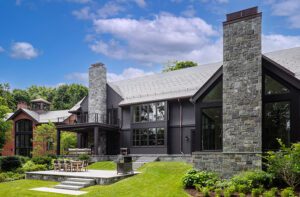Art for Architecture: Kent Bloomer
August 23, 2016
Ornament from Kent Bloomer’s New Haven, Connecticut studio makes buildings more beautiful.
Text by Debra Judge Silber
Tucked inside a brick factory complex in New Haven, Kent Bloomer’s studio exhibits the mix of casual disarray and studious intensity typical of a college art workshop. Scattered about the lofty space are metal stools and waste bins, hand tools, power cords, bottles of glue, and scraps of wood. Models of current projects, rendered in chipboard, wood, and clay, rest on sturdy tables, each an iteration toward the goal of making ordinary architecture extraordinary.
“We do hand sketches and build models for everything,” explains Bloomer, who oversees the eponymous studio dedicated to architectural ornament. “It’s a process of discovery, and it can take time.”
It also leaves behind in the workshop a landscape of past projects: a prototype of a capital for a tennis facility blooms from a ceiling support; a delicate web of lattice clings to a wall. The full-size realizations of these models, reproduced in stone, aluminum, bronze, or steel, dot the country, where they make the experience of walking into libraries, schools, or homes an artistic encounter.
The studio’s award-winning installations include a leafy trellis that scales a wall at Ronald Reagan National Airport in Washington, D.C., seven massive sculptures adorning the roof of Chicago’s Howard Washington Library, and a magnificent set of aluminum stallions leaping through feathered wings atop the Great Platte River Road Archway near Kearney, Nebraska. Not all of the studio’s work is large-scale, however—New Haven in particular is the beneficiary of a number of smaller projects that include graceful lampposts illuminating the Yale University campus, and leafy archways and intricate gates at city schools. On a still smaller scale, the studio’s private commissions include a painted mahogany lattice that adorns the side of a pavilion on a Long Island estate, and a staircase in a Guilford home encrusted with bronze forms patterned after marine life in the nearby salt marsh.
Large and small, the studio’s work recalls a time when a molded cornice or embellished frieze was as much a part of architecture as windows and doors. It reflects Bloomer’s personal response to the bland modernism that became the rule in the 1950s, when he capped a degree in physics with another in architecture at the Massachusetts Institute of Technology (he went on to study sculpture at Yale, where he now teaches). He tells of a professor who displayed a photograph of Louis Sullivan’s 1899 Carson, Pirie, Scott Building in Chicago, then instructed students to ignore the building’s elaborate ironwork to focus on “what’s really important”— the unadorned structure above. Bloomer could not. “The ornament is what brings everything together,” he says. “It can be part of a building, just as a building can be part of a city.” Ornament’s ability to link structures to the larger world, Bloomer says, “was an epiphany for me.”
This contextual aspect separates what Bloomer defines as ornament from what others might dismiss as decoration. Ornament, he explains, ties a structure to the world around it. Decoration, like the word decorum, is rooted in symbols of taste and social propriety. It may seem an academic distinction, but it matters to Bloomer, whose experience designing ornament is surpassed only by his years studying, writing, and teaching about it. In Bloomer’s designs, that natural context frequently takes the shape of leaves—or abstractions of leaves. Birds are common in Bloomer’s work as well, as in the seagull shapes that resolve, Escher-like, across a trellis he designed for a New Haven middle school. But not all of the studio’s references to nature are so easily read. It’s unlikely a casual stroller passing the gate at Yale’s Chemistry Research building would recognize the cubic lattice, tetrahedrons, and cast-bronze peptides that spell out Yale and Chem in molecular language worked into the design.
Bloomer starts the design process with hand sketches, then collaborates with William Jelley, a fabricator and sculptor, and Ioana Barac, a visual designer and architect, to resolve the details of each project using the three-dimensional models. Once final prototypes are complete, the design is reproduced in metal or stone by a select group of fabricators, welders, and foundries, most of them in Connecticut.
While the studio’s large public projects take years to develop and carry price tags of more than $1 million, Bloomer will consider residential projects in the $25,000 to $30,000 range. “The difference between large public projects and those for the home are largely matters of scale,” he says.
Bloomer wants to make all of the buildings we inhabit more beautiful. “Stripped-down design has enjoyed the last fifty-plus years,” he says. “There is a deep sense of loss today in the cultural and visual quality of the built environment.”
It’s something his studio is working to change, one leaf at a time. •
Kent Bloomer Studio
New Haven
(203) 562-7559
bloomerstudio.com
Share
![NEH-Logo_Black[1] NEH-Logo_Black[1]](https://b2915716.smushcdn.com/2915716/wp-content/uploads/2022/08/NEH-Logo_Black1-300x162.jpg?lossy=1&strip=1&webp=1)














You must be logged in to post a comment.